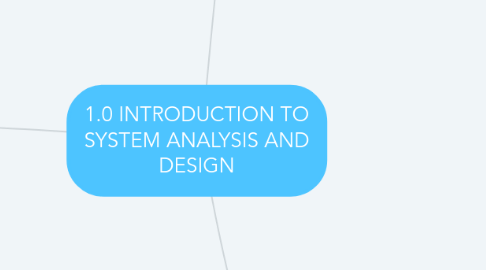
1. 1.3 Understand Project Management
1.1. 1.3.1 Explain project planning, scheduling, monitoring, and reporting. 1.3.2 Explain steps in project planning. 1.3.3 Describe work breakdown structures, task patterns, and critical path analysis. 1.3.4 Create a work breakdown structure. 1.3.5 Explain techniques for estimating task completion times and costs. 1.3.6 Explain leadership and project manager.
2. 1.1 Discuss Information System.
2.1. An information system is the information and communication technology (ICT) that an organization uses, and also the way in which people interact with this technology in support of business processes.As such, information systems inter-relate with data systems on the one hand and activity systems on the other.
2.2. An information system is essentially made up of five components hardware, software, database, network and people. These five components integrate to perform input, process, output, feedback and control. Hardware consists of input/output device, processor, operating system and media devices.
2.3. A software development methodology or system development methodology in software engineering is a framework that is used to structure, plan, and control the process of developing an information system.Dynamic Systems Development Model (DSDM) Extreme Programming (XP) Feature Driven Development (FDD).
2.3.1. a. Structured Analysis Structured analysis is a software engineering technique that uses graphical diagrams to develop and portray system specifications that are easily understood by users. These diagrams describe the steps that need to occur and the data required to meet the design function of a particular software.
2.3.2. b. Object Oriented oriented analysis is a process that groups items that interact with one another, typically by class, data or behavior, to create a model that accurately represents the intended purpose of the system as a whole.
2.3.3. c. Agile/Adaptive MethodAdaptive methodologies range from Rapid Application Development (RAD), which basically prototypes products into existence, to Scrum, with its heavy reliance on team interaction, to XP, which takes adaptive to the extreme with its adoption of paired programming and constant reviews.
2.4. 1.1.3 Identify various types of information system.
2.4.1. Pyramid Diagram of Organizational levels and information requirements. Transaction Processing System (TPS) Management Information System (MIS) Decision Support System (DSS) Artificial intelligence techniques in business. Online Analytical Processing (OLAP)
3. 1.2 Discuss system development approach.
3.1. 1.2.2 Explain System Development Life Cycle (SDLC) activities:
3.1.1. a. Planning This is the first phase in the systems development process. It identifies whether or not there is the need for a new system to achieve a business’s strategic objectives.
3.1.2. b. Analyze The second phase is where businesses will work on the source of their problem or the need for a change.
3.1.3. c. Design The third phase describes, in detail, the necessary specifications, features and operations that will satisfy the functional requirements of the proposed system which will be in place.
3.1.4. d. Development The fourth phase is when the real work begins in particular, when a programmer, network engineer and/or database developer are brought on to do the major work on the project.
3.1.5. e. Testing The fifth phase involves systems integration and system testing (of programs and procedures)—normally carried out by a Quality Assurance (QA) professional—to determine if the proposed design meets the initial set of business goals.
3.1.6. f. Implementation The sixth phase is when the majority of the code for the program is written. Additionally, this phase involves the actual installation of the newly-developed system.
3.1.7. g. Maintenance The seventh and final phase involves maintenance and regular required updates. The seventh and final phase involves maintenance and regular required updates.
3.2. 1.2.3 Describe various types of life cycle models such as:
3.2.1. a. Waterfall model Represents the system in terms of data and the processes that objects that act upon that data.
3.2.2. b. Spiral Model Was suggested in the 1990s by Barry Boehm, a noted software engineering professor. He stated that each iteration, or phase, of the model must have a specific goal that is accepted, rejected, or changed by the user, or client. Thus, each iteration produces feedback and enhancements, which enable the team to reach the overall project goal
3.2.3. c. Iterative and incremental development Develop a system through repeated cycles (iterative) and in smaller portions at a time (incremental), allowing software developers to take advantage of what was learned during development of earlier parts or versions of the system.
3.2.4. d. Agile Model is the newest software development method Agile methods attempt to develop a system incrementally, by building a series of prototypes and constantly adjusting them to user requirements.
3.2.5. e. Prototyping model A prototype is an early working version of an information system. Prototyping tests system concepts and provides an opportunity to examine input, output, and user interfaces before final decision are made.
3.2.6. f. Rapid Application Development (RAD) is a team-based technique that speeds up information systems development and produces a functioning information system.
3.2.7. g. Joint Application Development (JAD) is a popular fact-finding technique that brings users into the development process as active participants.
3.3. 1.2.4 Identify appropriate life cycle models based on given scenario
3.4. 1.2.5 Describe project management activities:
3.4.1. • Project planning includes identifying all project tasks and estimating the completion time and cost of each. • Project scheduling involves the creation of a specific timetable, usually in the form of charts that show tasks, task dependencies, and critical tasks that might delay the project. Scheduling also involves selecting and staffing the project team and assigning specific tasks to team members. Project scheduling uses Gantt charts and PERT/CPM charts. • Project monitoring requires guiding, supervising, and coordinating the project team’s workload. The project manager must monitor the progress, evaluate the results, and take corrective action when necessary to control the project and stay on target. • Project reporting includes regular progress reports to management, users, and the project team itself. Effective reporting requires strong communication skills and a sense of what others want and need to know about the project.

